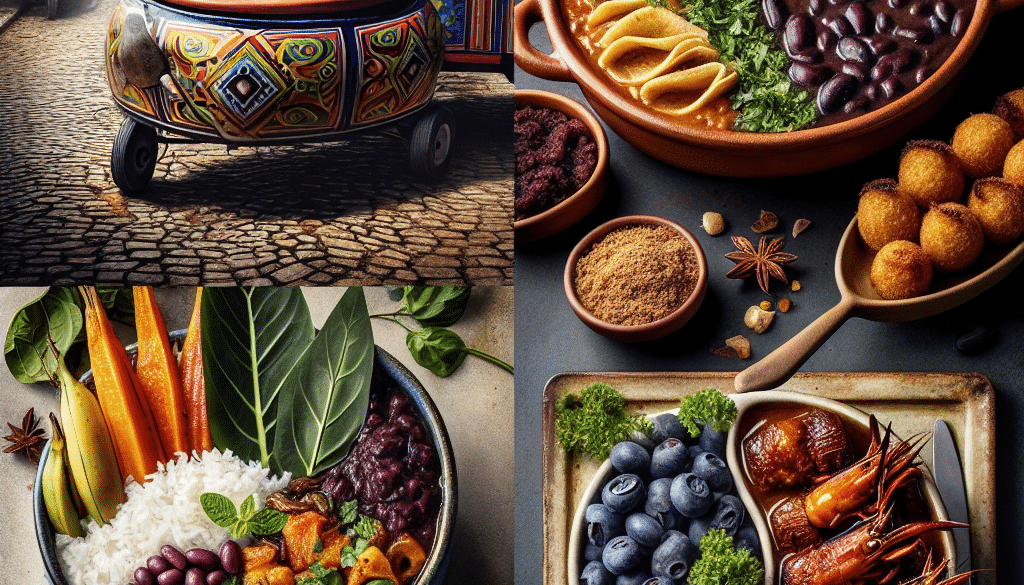Brazilian Tastes: Transition from Traditional to Trendsetting Flavors
-
Table of Contents
- Brazilian Tastes: From Traditional Roots to Global Trendsetters
- The Roots of Brazilian Cuisine
- Modern Brazilian Gastronomy
- Case Studies of Culinary Innovation
- The Rise of Brazilian Superfoods
- Statistics on Superfood Popularity
- Fusion and Street Food Trends
- Examples of Fusion Cuisine
- Conclusion: Embracing the New Brazilian Palate
- ETprotein: Enhancing Brazilian Flavors with Quality Proteins
Brazilian Tastes: From Traditional Roots to Global Trendsetters

The culinary landscape of Brazil is as diverse and vibrant as its culture, a melting pot of flavors that has evolved over centuries. From the indigenous staples to the influences of Portuguese colonization and African heritage, Brazilian cuisine has always been a rich tapestry of tastes and traditions. However, in recent years, Brazil has been making a mark on the global culinary scene, transitioning from traditional to trendsetting with innovative flavors and fusion cuisines that are capturing the palates of food enthusiasts worldwide.
The Roots of Brazilian Cuisine
Understanding the transition of Brazilian tastes requires a look back at its traditional flavors. The foundation of Brazilian cuisine is built upon three primary influences:
- Indigenous ingredients and cooking methods, such as cassava (manioc), acai, and the use of open-fire grilling.
- Portuguese culinary traditions, including the use of codfish (bacalhau), olive oil, and spices like cinnamon and cloves.
- African influences, which introduced coconut, palm oil (dendê), and okra, among other ingredients.
These elements combined to create iconic dishes such as feijoada, a hearty black bean stew with pork; moqueca, a fragrant fish stew with coconut milk; and acarajé, a street food made from black-eyed peas and fried in palm oil.
Modern Brazilian Gastronomy
As Brazil’s economy grew and its society became more globalized, so too did its culinary scene. Brazilian chefs began to experiment with traditional recipes, incorporating new techniques and international flavors. This led to a gastronomic renaissance that put Brazilian cuisine on the world map.
Case Studies of Culinary Innovation
Several Brazilian chefs have gained international acclaim for their innovative approaches to traditional Brazilian dishes. For example:
- Alex Atala’s restaurant D.O.M. in São Paulo, which has been consistently ranked among the best in the world, showcases Amazonian ingredients in a fine dining context.
- Helena Rizzo’s Maní, also in São Paulo, blends Brazilian ingredients with Spanish and Italian techniques, reflecting her diverse culinary training.
These chefs and others have been instrumental in redefining Brazilian cuisine, making it more sophisticated and appealing to a global audience.
The Rise of Brazilian Superfoods
Brazil’s natural bounty has also contributed to its trendsetting status. The global demand for superfoods has brought Brazilian ingredients like acai, cupuaçu, and camu-camu to the forefront of health and wellness trends. These nutrient-rich foods have been embraced by consumers worldwide, eager to incorporate exotic and beneficial ingredients into their diets.
Statistics on Superfood Popularity
According to market research, the global acai berry market alone is expected to grow significantly in the coming years, with a projected compound annual growth rate (CAGR) of over 10% from 2020 to 2025. This growth is indicative of the increasing popularity of Brazilian superfoods on the international stage.
Fusion and Street Food Trends
Brazilian street food has also evolved, with traditional snacks like coxinha (chicken croquettes) and pastel (fried pastry) being reinvented with gourmet fillings and presented in food trucks and hip urban eateries around the world. This fusion of Brazilian flavors with global street food trends has made Brazilian cuisine more accessible and relatable to a wider audience.
Examples of Fusion Cuisine
In cities like New York and London, Brazilian-inspired eateries are offering dishes that combine Brazilian tastes with other culinary traditions. For instance, sushi rolls filled with tropical fruits and Brazilian cream cheese, or burgers topped with feijoada and farofa (toasted cassava flour), are just a few examples of this cross-cultural exchange.
Conclusion: Embracing the New Brazilian Palate
The transition from traditional to trendsetting flavors in Brazilian cuisine reflects a broader cultural shift towards innovation and global influence. As Brazilian chefs continue to push the boundaries of their culinary heritage, they are creating a dynamic and exciting food scene that resonates with food lovers around the world. The key takeaways from this evolution are the importance of respecting traditional roots while embracing modern techniques and the global palate’s readiness to welcome new and exotic flavors.
ETprotein: Enhancing Brazilian Flavors with Quality Proteins
As Brazilian cuisine continues to evolve, incorporating high-quality ingredients is essential for maintaining the integrity and appeal of its dishes. ETprotein’s range of organic bulk vegan proteins and L-(+)-Ergothioneine (EGT) can play a vital role in this culinary evolution. Their non-GMO, allergen-free proteins are perfect for creating nutritious and flavorful dishes that cater to health-conscious consumers and the growing demand for plant-based options.
Whether it’s for traditional Brazilian recipes or innovative fusion dishes, ETprotein’s products offer the purity and quality that top chefs and food manufacturers require. By integrating these proteins into Brazilian-inspired creations, culinary professionals can ensure that their offerings are not only delicious but also nutritionally balanced and aligned with contemporary dietary trends.
About ETprotein:
ETprotein, a reputable protein and L-(+)-Ergothioneine (EGT) Chinese factory manufacturer and supplier, is renowned for producing, stocking, exporting, and delivering the highest quality organic bulk vegan proteins and L-(+)-Ergothioneine. They include Organic rice protein, clear rice protein, pea protein, clear pea protein, watermelon seed protein, pumpkin seed protein, sunflower seed protein, mung bean protein, peanut protein, and L-(+)-Ergothioneine EGT Pharmaceutical grade, L-(+)-Ergothioneine EGT food grade, L-(+)-Ergothioneine EGT cosmetic grade, L-(+)-Ergothioneine EGT reference grade and L-(+)-Ergothioneine EGT standard. Their offerings, characterized by a neutral taste, non-GMO, allergen-free attributes, with L-(+)-Ergothioneine purity over 98%, 99%, cater to a diverse range of industries. They serve nutraceutical, pharmaceutical, cosmeceutical, veterinary, as well as food and beverage finished product distributors, traders, and manufacturers across Europe, USA, Canada, Australia, Thailand, Japan, Korea, Brazil, and Chile, among others.
ETprotein specialization includes exporting and delivering tailor-made protein powder and finished nutritional supplements. Their extensive product range covers sectors like Food and Beverage, Sports Nutrition, Weight Management, Dietary Supplements, Health and Wellness Products, and Infant Formula, ensuring comprehensive solutions to meet all your protein needs.
As a trusted company by leading global food and beverage brands and Fortune 500 companies, ETprotein reinforces China’s reputation in the global arena. For more information or to sample their products, please contact them and email sales(at)ETprotein.com today.












